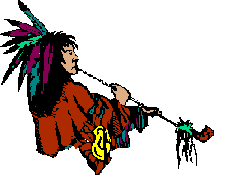| Earthwalk Creations | ||
|
|
History of the Tomahawk Pipe
The term "tomahawk" is a derivation of the Algonquian words "tamahak" or "tamahakan". The earliest definitions of these words (early 1600's) applied to stone-headed implements used as tools and weapons. Subsequent references involved all manner of striking weapons; wood clubs, stone-headed axes, metal trade hatchets, etc. As the years passed a tomahawk was thought of as any Indian-owned hatchet-type instrument. That association changed somewhat as white frontiersmen (traders, trappers, explorers) came to rely on the tomahawk as standard equipment. The popular perception of a tomahawk has become that of a lightweight (one lb. or less) metal head on a wood handle. With the exception of a relative few made by Indian blacksmiths, tomahawks were manufactured on a large scale in Europe or created by individual makers in America. Some were crafted in a most elaborate manner, with fancy engraving and pewter or silver inlaid blades and handles, for presentation to important chiefs in order to commemorate treaties and seal friendships. The majority of them, though, were personalized by their owners. Vastly different methods or adornment abounded - according to materials available and the customs and styles of the time and region. Hafts were polished smooth, carved, scalloped, inlaid, branded with hot files, tacked, wrapped with copper or brass wire, covered with rawhide, leather or cloth, stained, painted and hung with every type of ornament imaginable. Metals used (in rough chronological order) were solid iron, iron with a welded steel bit (cutting edge), brass with steel bit and lastly, solid brass (which diminished its usefulness as a wood-chopping tool). The end of the head opposite the cutting edge provided a place for a spike, hammer poll, or most ingeniously, a pipe bowl.
Source: --"Tools and Weaponry of the Frontiersman and Indian" by Ray Louis The Breath Of Prayer 
Thunder brought the blackstone pipe to the Blackfoot. The Great Spirit sent the pipe through Duck to the Arapahoe. The ancient prophet Sweet Medicine brought the arrow pipe bundle to the Cheyenne at Bear Butte. The Lakota have beautiful White Buffalo Calf Maiden. With the smoking of the first sacred pipe, the ancient Native American elders of this continent discovered in spiritual communion that to share breath is to share life. When the pipe is smoked, every bit of tobacco is thought to represent part of creation, so that all of creation is contained in the pipeís bowl. And as the ceremonial smoke wafts between peacemakers, all their good intentions are made plain to the creator. These stories of the origin of the Native American pipes are held as sacred to them as many Americanís beliefs of their origin through the existence of the Bible. Source: --"Calument History" by Toinette Trahan |
 Perhaps the most ubiquitous symbol associated
with Native Americans is the tomahawk. However, few people are aware of the multiformity
of its history as well as its physical characteristics.
Perhaps the most ubiquitous symbol associated
with Native Americans is the tomahawk. However, few people are aware of the multiformity
of its history as well as its physical characteristics. With a smoking pipe bowl and a drilled or hollowed handle, the pipe tomahawk became the most popular "hawk" of them all. It developed as a trade good by Euro-Americans for trade with native peoples. Iroquois men traded furs for these sought-after tomahawks. Ornate examples were presented at treaty signings as diplomatic gifts to Indian leaders, who carried them as a sign of their prestige. It was at once a weapon and symbol of peace for over 200 years and was carried, scepter-like, in the majority of photographic portraits of prominent Indian chiefs.
With a smoking pipe bowl and a drilled or hollowed handle, the pipe tomahawk became the most popular "hawk" of them all. It developed as a trade good by Euro-Americans for trade with native peoples. Iroquois men traded furs for these sought-after tomahawks. Ornate examples were presented at treaty signings as diplomatic gifts to Indian leaders, who carried them as a sign of their prestige. It was at once a weapon and symbol of peace for over 200 years and was carried, scepter-like, in the majority of photographic portraits of prominent Indian chiefs.